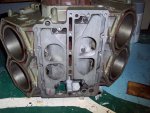I'm working on my 1980 v4 140 (ji140tlcsa) I first noticed the milkey substance on the number three spark plug after trying to track down a miss issue and very hard cold start issue. Once warmed up or underway motor ran great. So my first thought was head gasket. Ordered everything, pulled head and head gasket looked fine. Plenty of water and oil mix in the number 3 cylinder but other then that everything looked like it should. So, my next move was removing the hump back and I guess what you call the exhaust manifold. ( this is my first boat motor repair). The gasket had been destroyed and blown out in-between the exhaust port coming from that cylinder and where the exhaust exits the manifold. So I can see where that may be an issue but I'm trying to figure out if that is where my water could be coming from and if so, how does water get there? and if that isn't where the water is getting into the number 3 cylinder then where should I look next? i have cleaned carbs twice and set the float drop, checked timing, checked spark and did a de carb. Compression was 125 in 1,2,4 150 in 3.
Thanks!
Trying to get pictures up...
Thanks!
Trying to get pictures up...




















